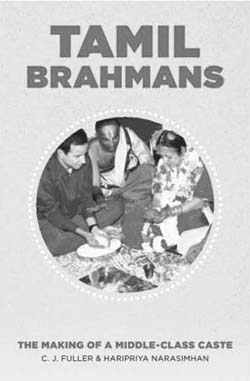The ‘Insider’ versus the ‘Outsider’ debate is not new in social science research. Indian sociology, in fact, has largely privileged the Outsider. Part of the reason for this phenomenon is that the late 18th and mid 19th century Orientalists were convinced that Outsiders like themselves were more capable than Natives of obtaining authentic knowledge, because of their guiding principles of ‘objectivity’ and ‘scientific rigour’. Even after Indian Independence, many sociologists believed that emotional and intellectual detachment was possible by studying a social group very different from one’s own. The writings of Katherine Gough (1951–52) and Andre Beteille (1961–62) on Brahman communities in villages near Thanjavur reveal this trend and figure prominently in a couple of chapters in the book under review.
Tamil Brahmins has been authored by Outsider C.J. Fuller, who is an Englishman, and Insider, Haripriya Narasimhan, a Tamil Brahman. As is pointed out in the Introduction, the Insider can provide a sensitive perspective of the community, based on her familiarity and empathy with the language, culture and customs of its people. Even though the book is written by Fuller, it is largely dependent on previous papers, interviews, and research (conducted between 2003 and 2008) by both the authors.
In 1931, when the last colonial caste-based Census was carried out, Brahmans constituted 2.5% of the population in the region today known as Tamil Nadu. Of this percentage, threequarters were Tamil Brahmans, while the rest included Telugu, Kannada, and Maharashtrian Deshastha Brahmans. Today, the population of Tamil Brahmans in the State is a broad estimate at 1.4 million, or just under 2% in the State. Given the fact that roughly one-quarter of the Tamil Brahman population are settled outside Tamil Nadu, in the rest of India or overseas, the total population of this community was estimated at 1.8 million in 2011. The fundamental narrative of this book is about the transition of Tamil Brahmans from a traditional rural elite class to a successful urban middle-class caste.
Indeed, the caste system is not about individual castes, but about interconnections. It is like the Kanchipuram sari woven on the warp and weft of the loom. Pull hard on one thread and the whole sari could unravel. There is no such thing as Brahman superiority without the subjugation of the Non-Brahman. As the late scholar M.S.S. Pandian had pointed out, even the appellation ‘Non-Brahman’ denotes a lack of whatever it is that constitutes the ‘Brahman’.
Continue reading this review

